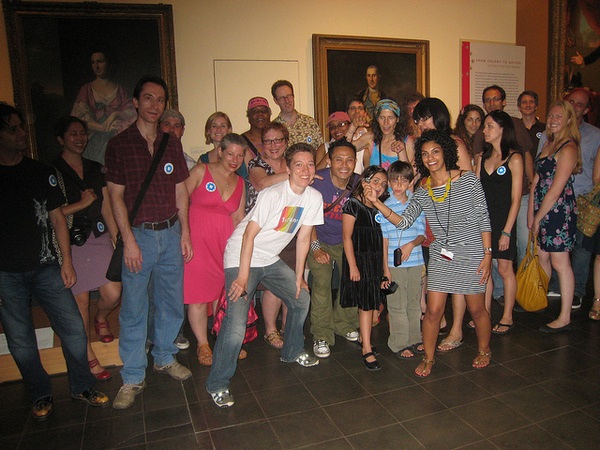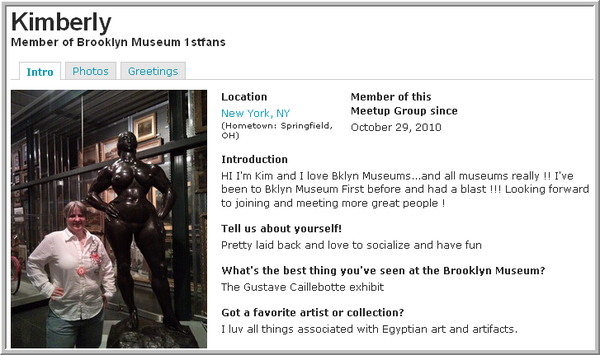1stfans: Shifting Focus and Moving to Meetup.com
As originally conceived, 1stfans was designed to engage both near and faraway supporters, but having run the program for almost two years, we’ve been seeing what works and what doesn’t and it’s time to respond and change the program. So far, members are having a great time at the Target First Saturday meetups and we’ve seen a high renewal rate from the ones who’ve attended those events. Simply put, the in-person benefits rock—people socialize and meet new friends while attending awesome meetups around museum content. By contrast, the online benefits have not worked as well and when we talked to our far-away supporters informally they indicated they were joining (and continuing to renew) out of general support for the museum, not necessarily to obtain a tangible benefit.
It’s because of this all of this that we are shifting focus to better accommodate the in-person meetup and changing the use of technology to support that goal. At the end of November, we will be discontinuing the use of Twitter, Facebook and Flickr groups for 1stfans and we’ll be moving our online operations to Meetup.com.

At the 1stfans meetup in June 2010, Tash managed to get a Key to City and we all got to open the secret door on the 5th Floor.
This is a long story of creating a program, learning as you go and finding the right technological fits along the way. I’m going to run down the specifics after the jump. If you are one of our readers that is new to 1stfans and would like to get caught up, you might check out Will’s introduction to the program and Nina Simon’s interview with the two of us during early days.
Twitter Art Feed:
As much as we loved the Twitter Art Feed, it wasn’t working and we were not seeing much user engagement. You may remember one of the artists, Joanie San Chirico, actually created an entire project to try and engage the folks that were quietly lurking in the background—a direct response to the issue at hand. In some ways, since many of the artists featured were 1stfans, the feed provided a way to get to know certain members through their projects, but overall user engagement was low and if the point of 1stfans was to socialize and get to know one another, Twitter didn’t work. Why? Well, simply put, Twitter is setup for a one-to-many communication and while it’s possible to have a many-to-many communication there, it’s not the norm and is difficult on the scale we need. Compared to what we were seeing in the building, the feed felt alien—like it wasn’t part of the program. Though we are sad to see it go, we couldn’t be more thrilled that Dennis Bass is going to send us off. We got to know Dennis after he became our Foursquare Mayor and he’s been a great supporter of ours—his project, which looks at our permanent collection, tagging and his own photography, is going to provide a lovely close to the feed. We’d like to take this time to thank the artists who contributed to the feed over the past two years—they created some amazing projects and utilized Twitter in very innovative ways. If you are curious for more, each project has its own blog post detailing the project and to celebrate them, we are making the feed public so you can scroll back through and take a look at these projects before the feed is deleted entirely.
Communication:
We setup Facebook, Flickr and Twitter for communication, but problems cropped up continually. As much as people are on the social networks, they are not consistently on them all the time and when they are there’s a flood of information coming their way as they try and catch up. Our communication and meetup announcements were getting lost in that wave. Also, the Facebook group structure (even with recent modifications) makes it difficult for people to get to know one another and communicate together. Too often, people have their profiles locked down, so if you are curious about somebody and click on their profile, you are faced with this brick wall:

Would have loved to get to know Nick a little bit, but are we really ready to be FB friends? Not sure I’m ready for that commitment!
If Facebook was difficult for communication, the use of Twitter bordered on comedy. You can’t DM users on Twitter unless you mutually follow each other. Too often, people were confused about the Twitter Art Feed being closed to members only. When they tried to follow, we had no way to communicate with them to explain and ask them to join. Here, this says it all. Twitter has these restrictions in place for good reason—you don’t want strangers soliciting you, especially when you could have your DMs going to your phone via SMS, but it stymied communication and there was no way around it. After November, these groups and feeds will be replaced by a single point of entry at meetup.com, which allows for better communication.
Administrative Overhead:
The online benefits have been difficult to manage internally. With private groups and feeds, we had to work hard to get people setup initially and you can imagine what a renewal cycle was like. For every member who didn’t renew, we’d have to go in and find their account to remove them from the group. This was an astounding time drain. While this could have been partially solved by allowing these groups to be public, that would have created other problems. For instance, if you open the Twitter Art Feed so anyone can join, what’s the point of it being a benefit of membership? There’s no good answer here, but since the Twitter Art Feed wasn’t working in other ways, we have a direction to go in that works to solve both problems.
Online Transactions:
The use of Google Checkout made it much easier for our members to join and renew, but it made things very difficult to manage internally. When members would join, we’d have to input their data by hand into Raiser’s Edge, the business system we use for tracking development and membership. In addition, we’d have to send reports from Google to our fiance office, so they could properly reconcile the transactions. This created too much overhead, so we’ve switched to using RE:NetSolutions, which is a product that integrates with our internal systems. To say we agonized over this change is putting it lightly. RE:NetSolutions provides a downright awful user experience, but it’s a change we felt we had to make for the 1stfans workload to become more manageable. At some point we will be able to dump RE:NetSolutions in favor of something better for transactions across the institution, but until then we are stuck {curses}.
Movin’ to Meetup:
You might be asking why moving to Meetup is going to make all this better. I’ve been using the site personally for a while and it’s hard to list all of the awesomeness it provides. I’ll start by saying Meetup has absolutely nailed getting people together in physical space and giving them just enough of an online push to help them do so. Here are just a few reasons why Meetup works so well:
1stfans has been on Meetup just a few days and it’s been heartwarming to see visitors finding us there and filling out their profiles so we can better get to know them. The Meetup.com structure facilitates this incredibly well and it is simply awesome.
- As a group admin, you can ask your members a few questions about why they are joining your group. Everyone who belongs to the group can see these answers and get to know them a little bit in context. This is not a major online relationship commitment—it’s just enough information to help all the members get to know each other and facilitate conversations at the events themselves.
- As a member, I can set my own privacy levels. I can elect to show which groups I’m a part of or not. I can decide if I’d like to allow other members to contact me via email and I can do this on a group by group basis. Ditto for my online life—I can share my Twitter, Facebook and Flickr handles if I want to, but otherwise keep it private or only share it with certain groups.
- Meetup has single sign-on using Facebook Connect, so I can use my FB credentials without the need of another account. Alternatively, if I’m not on Facebook, I can just use a meetup.com account. For people wary of Facebook and its problems with privacy, this is incredibly helpful.
- Meetup sends event announcements and reminders via email and allows members to export events into any number of calendar formats. I can adjust my email settings on a per-group basis. When I RSVP to an event, I can elect to share it to my social networks, but this is not forced and doesn’t happen by surprise—I know exactly what I’m sharing and when I’m doing it.
- Meetup allows each member to create widgets, so they they can help support us by spreading the word on their own blogs and sites. In addition, organizers can create name tags to be used at the event from the RSVP list, which saves a lot of time.
- As a group admin, I can greet every new member when they join which is one of the most important things one can do to make people feel welcome and facilitate community growth.
Overall, Meetup has created an experience that can be customized for each group member and I feel like my privacy is protected—I share what I want to, when I want to and it’s clear to me (very clear) what those options are. It feels like I’m a respected user and that, in turn, makes me feel safe going into real-world meetups and that’s how we want our members to feel. Bravo.
We are excited about these changes and when I scroll back through all of the 1stfans blog posts, I find myself incredibly proud of how much work we’ve collectively—the staff, the artists and, most of all, the members—put into the program. I’m looking forward to this next chapter and meeting new 1stfans and seeing old friends at our next meetup.

Shelley Bernstein is the former Vice Director of Digital Engagement & Technology at the Brooklyn Museum where she spearheaded digital projects with public participation at their center. In the most recent example—ASK Brooklyn Museum—visitors ask questions using their mobile devices and experts answer in real time. She organized three award-winning projects—Click! A Crowd-Curated Exhibition, Split Second: Indian Paintings, GO: a community-curated open studio project—which enabled the public to participate in the exhibition process.
Shelley was named one of the 40 Under 40 in Crain's New York Business and her work on the Museum's digital strategy has been featured in the New York Times.
In 2016, Shelley joined the staff at the Barnes Foundation as the Deputy Director of Digital Initiatives and Chief Experience Officer.


